
27 August 2007
Moose Jaw's Saskatchewan Western Development Museum
Moose Jaw Saskatchewan - Until the early nineteenth
century, the chief means of transporting people and goods across Western Canada was along natural waterways by canoe,
or over land by Red River cart, horseback, pack horse, or travois.
The railway played a crucial role in opening the West, delivering goods and passengers with ease.
Hop on board the WDM Shortline narrow gauge railway and tour the track outside the Museum. Steam and rail volunteers
operate the train on weekends and holidays May 24th to Labour Day (weather permitting).
View the photos below to travel the past with us and see part of Moose Jaw's WDM History of Transportation exhibit.
All photos were provided by Doug McKenzie on his recent visit to the museum:
| |
|
|
CP Rail 6553 is the Montreal Locomotive Works (MLW) version of
the American Locomotive Company (Alco) diesel-electric switcher model S-3 built in
1956. It contains a six cylinder model 539 diesel engine delivering 660 horsepower.
|
|
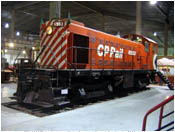 |
| |
|
|
Train speed and safety led railways to replace most of their
manual switching with Centralized Traffic Control (CTC) systems. This unit is the board which directed one of
these systems. Built by Union Switch & Signal of Swissvale, Pennsylvania, this particular dispatcher's board
was used by the Canadian Pacific Railway in Moose Jaw from 1959 to 1989.
With it, the dispatcher in Moose Jaw controlled traffic on the rail line from Broadview to Swift Current, a
distance of about 240 miles. The board was monitored 24 hours a day because the trains moved day and night. When
a train was on a certain section of track, a signal was sent to the board and a light went on showing the
dispatcher the location of the train. Signals came in on telegraph lines. The graph made a written record of all
train movements.
|
|
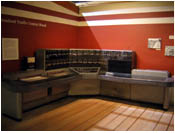
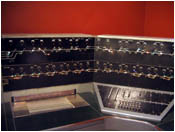 |
| |
|
|
This steam locomotive, number 2634, is a Canadian Pacific
Railway 4-6-2 Pacific type, class G2s. Ahead of the stack rests an Elesco feedwater heater. It was
not original equipment, but was applied during a later rebuild. The purpose of this device is to use exhaust
steam from the cylinders to pre-heat fresh water going into the boiler. Most North American steam
locomotives built, or rebuilt, after 1920 were equipped with feedwater heaters. Several common types were in
use such as the Elesco, the Worthington ( usually side-mounted ) and the Coffin.
|
|
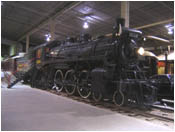 |
| |
|
|
In the 19th century, railroad building was a labour intensive
undertaking. One crew had to survey the road. Another crew followed to clear the roadbed of bush and trees. Stone
or gravel was laid and graded. Then the rail line was put in. First wooden ties were laid two feet apart across
the road. Then steel rails were laid 4 feet 8 1/2 inches apart down the length of the road. The rails were
fastened to the ties by plates and spikes. The labourers who built the rail line were known as
"navvys".
|
|
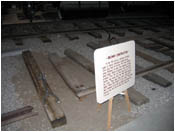 |
| |
|
|
These are manual powered handcars. The orange one is a typical
Canadian National Railways type with the yellow a Canadian Pacific handcar. In the background may be seen a
telegraph pole with a CPR mileage board attached which displays mile 118. These boards were attached to bridges
and structures along the line to identify the location.
|
|
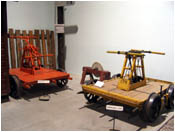 |
| |
|
|
A variety of specialized tools were required to build and
maintain rail lines. Some of them are shown here on this pushcart. A pushcart could be attached and pulled by a
motorized speeder which replaced handcars in later years.
|
|
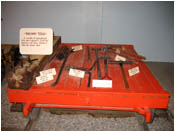 |
| |
|
|
One wall within the museum displays railway artifacts
commonly found at railway stations in Canada. How many of the items can you identify?
|
|
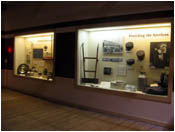 |
| |
|
|
A typical Canadian Pacific Railway station has been
re-constructed within the museum. The vehicle labeled M-499, an inspection car
manufactured from a highway vehicle by adding flanged wheels and other equipment, is the pre-cursor
to today's modern Hi-Rail vehicle.
|
|
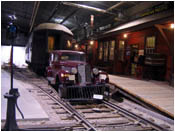 |

|